|
|
|
Sort Order |
|
|
|
Items / Page
|
|
|
|
|
|
|
| Srl | Item |
| 1 |
ID:
182661
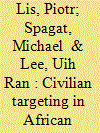

|
|
|
|
|
| Summary/Abstract |
Armed conflict actors frequently target civilian populations. Thus, an improved understanding of such behaviour could pave the way to reducing it. We use the Civilian Targeting Index (CTI) and a broad array of geo-referenced data to investigate the spatio-temporal and economic dynamics of civilian targeting by conflict actors in Africa. Two main insights are generated. First, the civilian targeting behaviour of African non-state conflict actors is strongly influenced by the behaviour of other proximate actors. In particular, non-state actors tend to increase their civilian targeting after nearby non-state actors have done so. Possible mechanisms to explain such spatial spillovers include emulation and retaliation. Second, a negative relationship between economic activity and civilian targeting exists and applies to both state and non-state actors. In addition, CTIs of non-state actors tend to increase with population density, the geographical spread of their conflict activity and conflict duration. State actors have higher average CTIs than non-state actors do, but the gap between the two actor types tends to close during long-duration conflicts.
|
|
|
|
|
|
|
|
|
|
|
|
|
|
|
|
| 2 |
ID:
192656
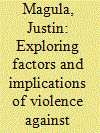

|
|
|
|
|
| Summary/Abstract |
The Soviet-Afghan War serves as a significant case study to understand why states resort to violent acts against civilians during war. This study takes a multidimensional approach, examining strategic, operational, and individual factors and applying theories of violence and mass killing. By analyzing the conditions that led the Soviets to target civilians, this investigation identifies a nexus of interconnected factors. At the strategic level, Soviet leaders pursued a swift victory to establish a Communist client regime while minimizing casualties and controlling information flow. Operationally, the ill-preparedness of the Red Army for counterinsurgency warfare, coupled with an entrenched organizational culture, led to the adoption of counterproductive enemy-centric tactics against Afghan noncombatants. Additionally, inadequate training, prolonged deployments, and a lack of disciplinary measures at the individual level contributed to the perpetration of violent acts. Understanding the underlying causes of violence against civilians, particularly in the context of Russian forces, holds practical importance. This knowledge can assist policymakers in devising strategies that mitigate wartime violence and enhance the protection of citizens. Drawing parallels to contemporary conflicts involving Russia, the study concludes by recommending future research directions and emphasizing the relevance of comprehending the targeting of noncombatants in ongoing conflicts, notably the Russian-Ukrainian conflict.
|
|
|
|
|
|
|
|
|
|
|
|
|
|
|
|
| 3 |
ID:
188070
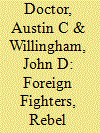

|
|
|
|
|
| Summary/Abstract |
Recent studies find that the presence of foreign fighters in a rebel organization may increase levels of anti-civilian violence in civil war. But why? Evidence from some cases indicates that foreign fighters may be used intentionally by local rebel commanders to carry out abusive operations against noncombatants. Other cases, however, suggest that foreign fighters possess greater capacity for independent agency in war, stepping outside the chain of command to inflict harm against local noncombatants. We argue that variation in a rebel group’s command structure—specifically, their degree of centralization—offers a point of leverage with which to adjudicate between the generalizability of these competing explanations. We investigate this issue with an analysis of sixty-nine rebel groups active between 1989 and 2015. We find that the effect of foreign fighters on civilian targeting is conditional: foreign fighters are associated with greater levels of anti-civilian violence only when active in groups with centralized command structures. This study contributes to the nascent literature on foreign fighters, offering insight into how these actors step into the command structures of rebel organizations. This study also demonstrates that the abuse of civilians in conflict can be explained effectively based on the characteristics of armed parties.
|
|
|
|
|
|
|
|
|
|
|
|
|
|
|
|
| 4 |
ID:
167432
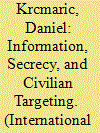

|
|
|
|
|
| Summary/Abstract |
Why do some states target civilians with violence whereas others exercise restraint? I argue regimes are more likely to victimize civilians when they believe that they can hide their actions and thereby avoid international and domestic blowback. This means that governments will prove less likely to commit atrocities in situations where information and communication technologies (ICTs) make secrecy and plausible deniability difficult. Statistical analyses provide strong support for this claim. The findings shed light on how ICTs shape violence and how states strategically employ secrecy.
|
|
|
|
|
|
|
|
|
|
|
|
|
|
|
|
| 5 |
ID:
181392
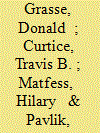

|
|
|
|
|
| Summary/Abstract |
Across the globe, states have attempted to contain COVID-19 by restricting movement, closing schools and businesses, and banning large gatherings. Such measures have expanded the degree of sanctioned state intervention into civilians' lives. But existing theories of preventive and responsive repression cannot explain why some countries experienced surges in repression after states in Africa initiated COVID-19-related lockdowns. While responsive repression occurs when states quell protests or riots, “opportunistic repression” arises when states use crises to suppress the political opposition. An examination of the relationship between COVID-19 shutdown policies and state violence against civilians in Africa tests this theory of opportunistic repression. Findings reveal a large and statistically significant relationship between shutdowns and repression, which holds after conditioning for the spread and lethality of the disease within-country and over time. A subnational case study of repression in Uganda provides evidence that the increase in repression appears to be concentrated in opposition areas that showed less support for Yoweri Museveni in the 2016 elections. Opportunistic repression provides a better explanation than theories of preventive or responsive repression for why Uganda experienced a surge in repression in 2020 and in what areas. The results have implications for theories of repression, authoritarian survival, the politics of emergency, and security.
|
|
|
|
|
|
|
|
|
|
|
|
|
|
|
|
| 6 |
ID:
167186
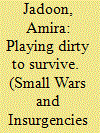

|
|
|
|
|
| Summary/Abstract |
U.S. military aid provides recipient governments the fighting capability they require to undermine domestic militant groups, which can undermine groups’ leadership structures and trigger group splintering. In this environment, brutal attacks against non-combatants become an effective mechanism for targeted groups to signal their resolve and outbid competitors. A large-n analysis of U.S. military aid between 1989 -2011 links higher levels of military aid with higher levels of rebel-perpetrated civilian killings, and deaths due to explosive attacks on non-combatant targets. A closer examination of the case of Pakistan sheds further light on the underlying causal mechanisms.
|
|
|
|
|
|
|
|
|
|
|
|
|
|
|
|
| 7 |
ID:
172832
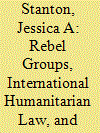

|
|
|
|
|
| Summary/Abstract |
Do rebel group violations of international humanitarian law during civil war—in particular, attacks on noncombatant civilians—affect conflict outcomes? I argue that in the post-Cold War era, rebel groups that do not target civilians have used the framework of international humanitarian law to appeal for diplomatic support from Western governments and intergovernmental organizations. However, rebel group appeals for international diplomatic support are most likely to be effective when the rebel group can contrast its own restraint toward civilians with the government's abuses. Rebel groups that do not target civilians in the face of government abuses, therefore, are likely to be able to translate increased international diplomatic support into more favorable conflict outcomes. Using original cross-national data on rebel group violence against civilians in all civil wars from 1989 to 2010, I show that rebel groups that exercise restraint toward civilians in the face of government violence are more likely to secure favorable conflict outcomes. I also probe the causal mechanism linking rebel group behavior to conflict outcomes, showing that when a rebel group exercises restraint toward civilians and the government commits atrocities, Western governments and intergovernmental organizations are more likely to take coercive diplomatic action against the government. The evidence shows that rebel groups can translate this increased diplomatic support into favorable political outcomes.
|
|
|
|
|
|
|
|
|
|
|
|
|
|
|
|
| 8 |
ID:
107994
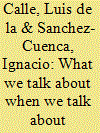

|
|
|
|
|
| Publication |
2011.
|
| Summary/Abstract |
There is no consensus in the literature about the nature of terrorism. The authors' main claim is that this is ultimately the result of the coexistence of two senses of the term, the action and the actor sense, which are not fully congruent. Rather than trying to advocate a specific conceptualization, the authors provide in this article a map of the different ways in which scholars talk about terrorism. They identify first the set of terrorist actions and the set of terrorist actors. Terrorist tactics are a variety of the power to hurt, based on the lack of military power. Terrorist groups are underground ones with no territorial control. When the two criteria meet, the core of terrorism exists: coercive violence perpetrated by underground groups. The ambiguity that surrounds terrorism is caused by two other possibilities: actors with some measure of territorial control adopting coercive tactics and underground actors adopting military tactics. Although it is not possible to remove this ambiguity in empirical research, scholars can at least identify it and analyze it. The authors illustrate the two senses of terrorism and their interaction by using the most comprehensive dataset on terrorist incidents, the Global Terrorism Database (GTD).
|
|
|
|
|
|
|
|
|
|
|
|
|
|
|
|
|
|
|
|
|